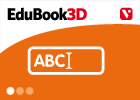Cargando...
Recursos educativos
-
Nivel educativo
-
Competencias
-
Tipología
-
Idioma
-
Tipo de medio
-
Tipo de actividad
-
Destinatarios
-
Tipo de audiencia
-
Creador
Lo más buscado
- Divisiones para niños educación parvularia
- Letra ll
- Seres inertes
- Animales dibujados
- Dictado de palabras agudas
- Juegos de tablas de multiplicar
- Repaso de lengua castellana para cuarto
- Biosfera para primero
- Medidor de distancia
- Aprender a leer jugando
- verbos irregulares
- Rios de América
- Experimentos naturales
- imágenes matemáticas
- Alteración del lenguaje
-

The five groups of vertebrates
EduBook Organización
- 4148 visitas
Fish have an elongated body and swim using their fins. Amphibians live part of their life in water. Their skin is moist and slippery. Reptiles crawl to move around. Their bodies are covered with hard…
-

True/false. Characteristics of vertebrates
EduBook Organización
- 4138 visitas
Decide if the following sentences are true or false: Vertebrates are the largest animal group on Earth. ➝ Almost all vertebrates have limbs. ➝ Limbs are called wings when they are used for flying.…
-

Analyse. Cell cultures
EduBook Organización
- 4097 visitas
Cell cultures Cell cultures consist of cultivating cells, both animal and plant, in the laboratory. We do this to obtain cell tissue. The tissues obtained from animal cells can repair or substitute…
-

The senses
EduBook Organización
- 3866 visitas
We receive information on what is happening outside our body through our sensory receptors. These receptors are specialised nerve cells that capture stimuli from outside our body. There are different…
-

Adrenaline prepares for action
EduBook Organización
- 3387 visitas
In situations of danger or fear, the adrenal glands produce a hormone called adrenaline. This prepares the body for action, like running or hiding. This is called the fight or flight response.…
-

Worms and molluscs
EduBook Organización
- 3201 visitas
Worms Worms are animals with long, soft bodies and moist skin. They do not have legs; they move by wriggling. Most worms live in the sea or in fresh water. Some live on land, like earthworms. Some worms…
-

Complete. The receptors
EduBook Organización
- 3113 visitas
Complete the text using the following words: taste cells - taste buds- cones - hair cells - pressure - receptors - are cells that specialise in receiving stimuli and transmitting them to the brain. In…
-

-

Summaries - The Animal Kingdom (II). Vertebrates
EduBook Organización
- 2946 visitas
1. Fish Fish are perfectly adapted to aquatic life. There are two main groups of fish: bony fish and cartilaginous fish. Most fish are bony fish such as hake, salmon and trout. Sharks and manta rays are…
-

Te estamos redirigiendo a la ficha del libro...













